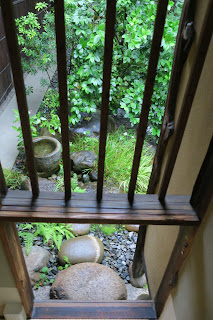Naramachi Nigiwai-no-ie is a building that was recognized as a Registered
Tangible Cultural Artifact. It is a machiya house that was built about 100
years ago, and was simultaneously both an antique shop and a house. The
lattice gives it an incredibly beautiful exterior that catches one’s eyes and
leaves an impression.
With its tatami room, tea room, tori-niwa space, and wood-fire pot, you can
experience what life was like in a traditional Japanese house a long time ago.
|
Naramachi Traditional House (Naramachi Nigiwai-no-Ie).
At the southwest corner of the block on the west side of Kofukuji
Temple, you can see the old Machiya style merchant house, which is
opened to the public for free.
|
|
Naramachi Nigiwai-no-Ie guide map.
|
|
Passage way.
The Todai-ji Temple foundation stone is on the left side.
|
|
Alcove.
Old woods from Todai-ji Temple are used for the alcove.
|
|
Altar room (Butsuma).
A Butsudan (lit. "Buddhist altar"), sometimes spelled Butudan, is a
shrine commonly found in temples and homes in Japanese Buddhist
cultures.
-
The defined space which occupies the Butsudan is referred to as
Butsuma.
-
See more at
Butsudan - Wikipedia.
|
|
Detached room.
Hanare for his predecessor.
|
|
Kitchen (Daidokoro).
The original name for a Japanese kitchen comes from the stove itself.
-
In most historical Japanese kitchens, you’ll find a wood or
charcoal-fueled stove, upon which a metal pot sits. Up until the Meiji
period the kamado, the Japanese name for this type of stove,
was how many referred to what we now call a kitchen.
|
|
Courtyard for season.
With the concept of 24 seasons, they prepare the rooms so we can enjoy
the taste of each season, enjoying events and loving the seasons,
providing a space where we can live with nature.
-
The 24 seasons are 24 periods based on the movements of the sun
throughout the year. A long time ago, each of those periods was given
a name, and many of those names are still used in Japan today as words
to describe the seasons.
-
In Japan there is a traditional system of 72 microseasons (ko),
consisting of 24 solar terms (sekki) each divided into three
sets of five days, and with specially-named days or
Zassetsu indicating the start and end of each.
-
This system was adapted from the Chinese in 1685 by court astronomer
Shibukawa Shunkai, rewriting the names to better match the local
climate and nature in his native Japan.
-
Each ko has traditional customs, festivals, foods, flowers and
birds associated with it.
-
See more at
Japanese calendar - Wikipedia.
|
|
Hut waiting for the tea cerimony.
The guests arrive a little before the appointed time and enter an
interior waiting room, where they store unneeded items such as coats,
and put on fresh tabi socks.
-
When all the guests have arrived and finished their preparations, they
proceed to the outdoor waiting bench in the roji, where they remain
until summoned by the host.
-
The Roji, lit. 'dewy ground', is the Japanese term used for the garden
through which one passes to the chashitsu for the tea ceremony. The
roji generally cultivates an air of simplicity.
|
|
Washbasin (Tsukubai).
Following a silent bow between host and guests, the guests proceed in
order to a tsukubai (stone basin) where they ritually purify themselves
by washing their hands and rinsing their mouths with water, and then
continue along the roji to the tea house.
-
In Japan, a tsukubai is a washbasin provided at the entrance to a holy
place for visitors to purify themselves by the ritual washing of hands
and rinsing of the mouth.
-
The name originates from the verb tsukubau, meaning "to crouch"
or "to bow down", an act of humility.
-
Guests attending a tea ceremony crouch and wash their hands in a
tsukubai set in the tea garden (roji) before entering the tearoom.
-
See more at
Tsukubai - Wikipedia.
|
|
Low square door (Nijiriguchi).
The guests remove their footwear and enter the tea room through a small
"crawling-in" door (Nijiriguchi).
-
The entering to the tea room is made through a low, square door called
nijiriguchi, or "crawling-in entrance", which requires bending low to
pass through and symbolically separates the small, simple, quiet
inside from the crowded, overwhelming outside world.
-
The Low square door (Nijiriguchi) leads directly into the tea room.
|
|
Tea room (Chashitsu).
The Tea room (Chashitsu) in Japanese tradition is an architectural space
designed to be used for Tea ceremony (Chanoyu) gatherings.
-
The tea room has a low ceiling and no furniture: the guests and host
sit seiza-style on the floor. All materials used are intentionally
simple and rustic.
-
See more at
Chashitsu - Wikipedia.
|
|
Scroll alcove (Tokonoma).
The guests proceed to view the items placed in the Scroll alcove
(Tokonoma) and any tea equipment placed ready in the room, and are then
seated seiza-style on the tatami in order of prestige.
-
Inside the Tea room (Chashitsu) there is a Scroll alcove (Tokonoma)
holding a scroll of calligraphy or brush painting, and some times a
small, simple, flower arrangement called a chabana, but no
other decoration.
-
When seating guests, the correct etiquette is to seat the most
important guest closest to the tokonoma as this is in the location
furthest from the entrance, a location called the kamiza.
-
See more at
Tokonoma - Wikipedia.
|
See also
Source
Location




























